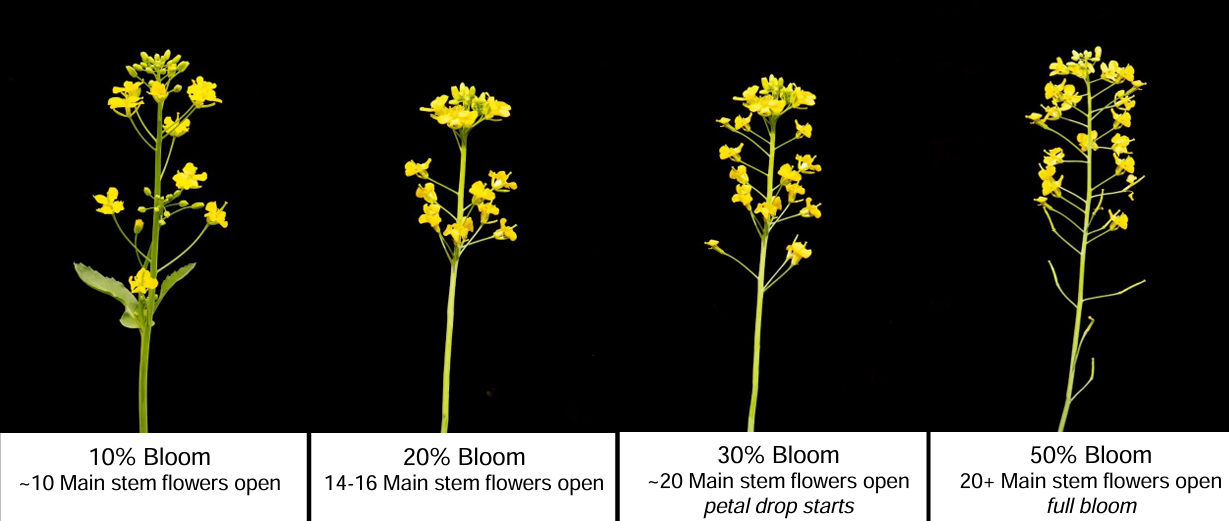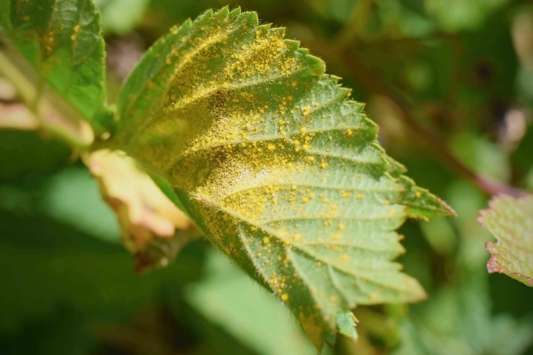Registered foliar fungicides for broadacre crops
For details on foliar fungicide application rates, adjuvants, withholding periods, and other instructions, refer to product labels. See the crop-specific factsheets for Registered foliar fungicides for Western Australia, linked below. These are updated each year and intended as a guide only.
Registered foliar fungicides for Western Australia 2024-25
Registered foliar fungicides for barley
Registered foliar fungicides for canola
Registered foliar fungicides for oats
Seed dressing and in-furrow fungicides for broadacre crops
Seed dressing and in-furrow fungicides contain active ingredients for the control or suppression of seed-borne diseases, some fungal foliar diseases and some fungal root rots in cereal and canola crops.
Information is provided on fungicide active ingredients that are registered for use in WA.
See the crop-specific factsheets, Seed dressing and in-furrow fungicides for individual cereal crops in WA, linked below. These are updated each year and intended as a guide only.
Seed dressing and in-furrow fungicides in Western Australia 2024-25
Seed dressing and in-furrow fungicides for barley
Seed dressing and in-furrow fungicides for canola
Seed dressing fungicides for oats
Fungicide application at seeding
At seeding, fungicides can be applied to seed (seed dressing) or soil (coated on drilled fertiliser or as a liquid and applied in-furrow) to be taken up by seedlings.
Seed dressing fungicides provide protection from seed-borne diseases, such as smuts and bunts in cereals. Some seed dressing and/or in-furrow products suppress early foliar diseases. In wheat, these include yellow spot, powdery mildew, and leaf or stripe rust and fungal root rots, such as pythium, rhizoctonia, crown rot, and take-all. In canola, these include blackleg, hypocotyl rot, downy mildew, damping off, and root rot.
Seed dressing and in-furrow fungicides contain one or more active ingredients and are marketed under many different trade names. When choosing seed dressing or in-furrow fungicides, consider the range of diseases that threaten your crop.
Before seeding, reassess your disease risk by considering seasonal and crop disease forecasts for your local area.
For product registration details, consult:
- product labels
- the Australian Pesticides and Veterinary Medicines Authority’s (APVMA) Public Chemical Registration Information System Search, linked below under Related content
- lists of registered 'seed dressing and in-furrow fungicides' (active ingredients) by crop.
Fungicides are effective only on diseases caused by fungi. Sometimes, plant symptoms that resemble those caused by pathogens are caused by non-pathogens, such as nutrient deficiencies or toxicities and adverse weather conditions.
For help diagnosing a disease, contact the department’s disease diagnosis service (DDLS) plant pathology services. This is a chargeable service.
Visit DDLS for more information
Once you have correctly identified the disease in your crop, find the relevant registered active ingredient by referring to the crop specific factsheet, linked on this page. These are updated each year and are intended as a guide, only. To help keep them up to date, email Ciara Beard (contact details below, under Contact us) with new registration information.
For details on the products or trade names that contain a specific active ingredient, search the Australian Pesticides and Veterinary Medicines Authority's (APVMA) Public Chemical Registration Information Systems Search (PubCRIS) database (portal.apvma.gov.au/pubcris), linked below under Related content, or contact your agronomist or chemical provider.
It is vital to read product labels before applying fungicides to ensure the chemical is registered for use on the crop and for the spectrum of diseases present, and for:
- withholding periods
- specific application instructions.
Be careful of tank mixes with other products. In some instances, fungicide sprays need to be mixed with an adjuvant (refer to label).
Variety resistance ratings
Refer to the current Western Australian crop sowing guide, for disease resistance ratings for crop varieties.
See the online tool, PestFacts WA Map for information on diseases present throughout the grainbelt each growing season.
Timing
Fungicides are more effective when applied in the initial stages of a disease outbreak, so routinely monitor your crop for disease to enable timely application of fungicide. In some situations, follow-up fungicide application may be needed to extend protection.
Most information on optimal application timing is provided on fungicide product labels.
For information on recommended application timings for the management of specific diseases, search this website for the disease.
See the guide to canola bloom stages below to help correctly identify when fungicide should be applied to canola.

How to apply foliar fungicides
Apply fungicide to the plant surface using recommended application methods, including correct volume of water, and nozzles to manipulate the droplet size. These are often described on product labels. In high disease situations, higher spray volumes will be beneficial to penetrate lower parts of the canopy.
For fungicides to effectively reach their target, they need to be applied using medium sized droplets (100 to 300 micrometres).
When choosing an application method (ground or aerial), consider timeliness and cost of application, including potential crop damage.
More information on application methods, including water volumes, adjuvants, and spray quality, see the Grains Research and Development Corporation (GRDC) fact sheet, Foliar applications of fungicides and insecticides. Other useful resources are GRDC publications, Mixing and batching agricultural chemicals, and Adjuvants booklet, linked under Related content.
The department and national collaborators have developed the following disease management tools to help with decision-making about the economics of foliar fungicide application to crops:
Wheat
Pulses – Mung bean
Economic considerations and decision support tools for managing blackleg
Growers are encouraged to consult their advisor when deciding whether to use fungicides at seeding. The effectiveness of fungicide application at seeding depends on the amount of disease pressure and level of varietal resistance. The point at which fungicide application at seeding is economic depends on the cost of application and resulting potential yield loss.
Use our Canola blackleg spore shower risk forecast page in conjunction with the BlacklegCM app to assist decision making on managing blackleg stem canker in your canola crop and determine if a seed dressing or in-furrow is needed prior to sowing for blackleg crown canker.
The Canola blackleg spore shower risk forecast page predicts the onset of blackleg ascospore release from canola stubble at the critical stage of seedling susceptibility for locations in the canola growing districts of WA using weather data from the nearest weather stations. This information allows growers to manipulate the time of sowing, if possible. This forecast is available at weekly intervals from the start of each growing season. Growers are recommended to check the forecast prior to sowing, and when crops are at the 2 to 3 leaf stage.
Responsible use of fungicides is vital to delay the development of fungicide resistance, which occurs when populations of a pathogen are no longer controlled adequately by fungicide application.
Fungicide resistance usually develops as a response to repeated use of a single fungicide active ingredient. It can also occur through repeated use of closely related fungicide active ingredients using a similar mode of action.
Fungicide resistance
Fungicide resistance to DMI (Group 3) fungicides has been detected in WA in the barley diseases, net form net blotch, spot form net blotch, and powdery mildew.
Resistance and reduced sensitivity to SDHI (Group 7) fungicides has been detected in barley spot form net blotch and net form net blotch in WA. Reduce the risk of fungicide resistance by reducing disease risk through an integrated disease management approach, by using options such as variety selection, crop rotation, adhering to fungicide product label recommendations, and rotating or alternating fungicide activity groups.
The following resistance management practices are recommended by Croplife Australia and the Australian Fungicide Resistance Extension Network:
- Rotate fungicides to prevent overuse of any one product or chemical activity group. Follow label instructions and avoid using the same chemical/mode of action more than necessary. All fungicide products sold in Australia are classified according to the chemical activity group (mode of action) of their active constituent. The activity group is indicated by a number code or letter/number combination on the product label. For a complete list of chemical activity groups, see the Fungicide activity group table on the Croplife Australia website, linked below under Related content. Consider the need to apply fungicide as seed dressings or in-furrow with fertiliser, to prevent or delay fungicide resistance.
- Fungicides work best by applying them in the most effective and appropriate manner. Always use the label rates recommended by the manufacturer.
- Use fungicides in conjunction with integrated disease management tools, such as resistant varieties, to result in fewer or less and frequent fungicide applications being required.
Seeding and in-furrow fungicide treatments
Carefully read and follow directions on fungicide labels to ensure correct and even rate application, and safety for seed and farm staff.
In-furrow treatments should be applied as close as possible to the seed for maximum effectiveness because roots must grow through the fungicide treated fertiliser to achieve an effective uptake of the fungicide. Uneven application and poor placement of the fertiliser could significantly reduce the fungicide effectiveness. In-furrow treatments should not be applied directly to seed.
In some situations, fungicide seed dressings may reduce coleoptile length in cereals. This could lead to 'silly seedling syndrome' (leaves that grow under the soil surface but don't emerge) if short coleoptile varieties or deep sowing are used. Check chemical labels for this information.
Coleoptile shortening may also result from use of dinotroaniline herbicides (trifluralin, pendimethalin, oryzalin). Take care when using coleoptile shortening seed dressings with these herbicides in cereals, particularly where it is difficult to obtain good depth control of herbicide incorporation and seed placement, such as in sandy soils.
Seed contaminated with fungicide (that is, pickled seed) should not be delivered to CBH or as animal feed.
Crop Sowing Guide
The Western Australian crop sowing guide is a one stop shop for information on all the major crops grown in Western Australia, compiled by the department. This edition includes the major crops grown in WA – wheat, barley, canola, oat, lupins, and pulses. The guide aims to provide information to support growers with decisions on the best choice of variety for each of the major crops for the upcoming season.
View the current Crop Sowing GuideRelated Links
- Managing barley powdery mildew in the face of fungicide resistance (DPIRD Library)
- Adjuvants Booklet (Grains Research and Development Corporation)
- Australian Fungicide Resistance Extension Network
- CropLife Australia
- Foliar applications of fungicides and insecticides fact sheet (GRDC)
- Fungicide activity group table (CropLife Australia)
- Fungicide Resistance Management in Australian Grain Crops (Australian Fungicide Resistance Extension Network)
- Fungicide Resistance Management Strategies (CropLife Australia)
- Public Chemical Registration Information Systems Search (PubCRIS) database
- Mixing and batching for agricultural chemical application - Grower case studies

